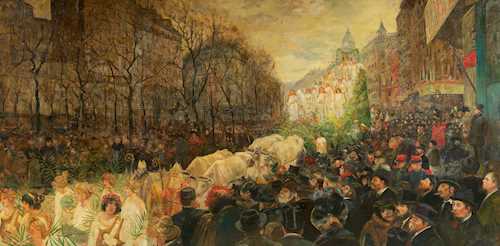
Lotto 3211* - A206 Dipinti del XIX secolo - venerdì, 22. settembre 2023, 16h00
LOUIS ABEL-TRUCHET
- Cabaret des Quat'z-Arts, Paris, until at least 1910.
- European private collection.
In the 19th century, Montmartre became the latest district of Paris to emerge as a result of the urban planning of Georges-Eugène Baron Haussmann. Both workers and wealthy families occupied the neighbourhood. Plaster mining, Montmartre's most important industry, gave its name to the newly built square, Place Blanche. Nevertheless, Montmartre attracted many artists, such as Auguste Renoir (1841–1919), Vincent van Gogh (1853–1890), Theéphile-Alexandre Steinlen (1859–1923) and Henri de Toulouse-Lautrec (1864–1901), who were able to access a more liberal and more affordable life here.
In 1896 and 1897, two parades were held in Montmartre called the ‘Vachalcades’, with the aim of creating a relief fund for artists living in poverty. The name is composed of the words ‘vache’ and ‘cavalcade’ and refers to the ‘vache enragée’ a symbol of lean times and the emblem of bohemian life. Its counterpart, the ‘Bœuf Gras’ was the focus of all satirical parades that took place in Paris under Napoleon III. Both symbols vied with each other in Montmartre during the Belle Époque. The Vachalcades enjoyed great popular success and were even mentioned in foreign newspapers, although they ended in financial disaster.
The painter Louis Abel-Truchet, who was known for his street scenes, designed a float called ‘L'Ode au Sacré Cœur’ for the first procession of 1896, which he depicts in the painting offered here, set in Place Blanche. The Sacré Cœur church, which was not quite finished at that time, can be seen at the top of the float and is sung to by a choir of angels. The sacred building was intended to confer on the district, which was characterised by religious indifference and socialist machinations, a significant tone of nationalism and piety, and the satirical Vachalcade makes no bones about this. Thus, the Moulin Rouge, visible in the background on the right, is also to be understood as a symbolic counterpart to the Sacré Cœur.
The painting continued to be exhibited in the Cabaret des Quat'z-Arts until the early 20th century (Fig. 1). The cabaret, like the better-known ‘Le Chat Noir’, was an entertainment venue and meeting place for many artists. The Quat'z-Arts opened at the foot of the Montmartre hill in December 1893 and was the meeting place of the organisers of the Vachalcades.
Our thanks to Laurent Bihl for his scholarly assistance in cataloguing this painting (see also Laurent Bihl: L'Armée du chahut. Les deux Vachalcades de 1896 et 1897, Sociétés & Représentations 2009/1, no. 27, pp. 167–191).
CHF 7 000 / 9 000 | (€ 7 220 / 9 280)
Venduto per CHF 8 750 (incl. premio dell'acquirente)
Non si assume alcuna responsabilità per la correttezza di queste informazioni.


